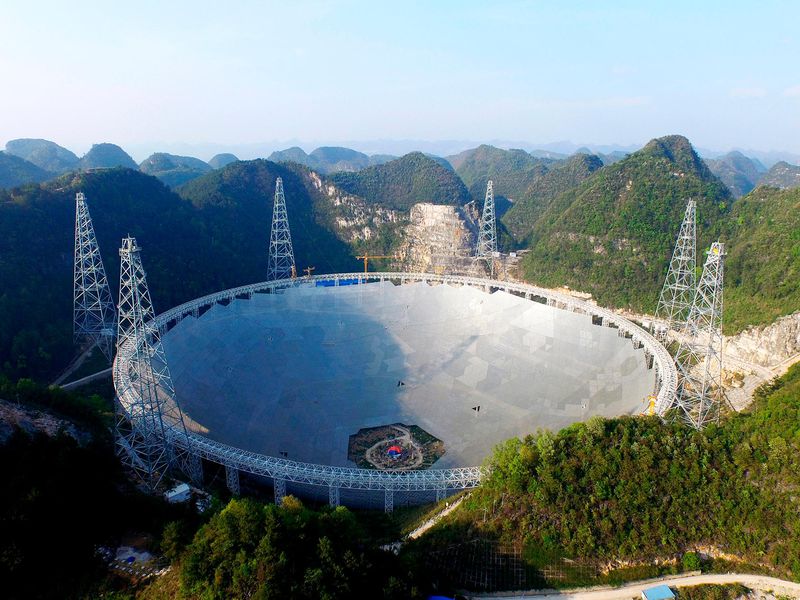Citizens with their suspect UFO “sightings” have given the search for extraterrestrial intelligence a bad name in America as assuredly as Timothy Leary made the potential medical benefits of LSD long unspeakable. But considering how much is out there—including stars like our sun and planets like our own—the odds are that we’re not alone.
· · ·
China is set up to hear first if extraterrestrials make contact with humans any time in the foreseeable future, since that nation has invested most heavily in the technology necessary to enable such a meeting of the minds. Does it matter if a totalitarian regime is at the head of the line to greet the otherworldly? (That’s supposing, of course, that China remains autocratic.) Probably not, considering the Earth-shaking enormity of the event, one that would likely render any political designations meaningless. Of course, some probably felt the same about the original Space Race, and that didn’t turn out to be true, with numerous practical advantages subsequently enjoyed by America. But the realization of a close encounter with alien life would dwarf even boots on the moon.
· · ·
Its realization of a village-clearing SETI telescope makes clear, however, that China is committed to science as America has taken a sharp turn from it, at least at our highest levels of government. If the autocratic state surpasses the U.S. and the rest of the planet in not only alien detection but also in solar panels, supercomputers, physics, etc., China would possess a soft power to go along with superior hardware, which would have a profound effect on world order. China’s dominance isn’t fait accompli, of course, as its poisonous dictatorial politics is a serious impediment to scientific growth. The valuable messiness of democracy may ultimately be a natural outgrowth of its continued development.
· · ·
In Ross Andersen’s wonderfully written Atlantic account of his trek to China’s premier SETI setup, which looks like a caved-in Apple campus dotted with oil rigs and is the “the world’s most sensitive telescope,” the author visits with novelist Liu Cixin and revisits the populous state’s scientific history. An excerpt:
A week later, I rode a bullet train out of Shanghai, leaving behind its purple Blade Runner glow, its hip cafés and craft-beer bars. Rocketing along an elevated track, I watched high-rises blur by, each a tiny honeycomb piece of the rail-linked urban megastructure that has recently erupted out of China’s landscape. China poured more concrete from 2011 to 2013 than America did during the entire 20th century. The country has already built rail lines in Africa, and it hopes to fire bullet trains into Europe and North America, the latter by way of a tunnel under the Bering Sea.
The skyscrapers and cranes dwindled as the train moved farther inland. Out in the emerald rice fields, among the low-hanging mists, it was easy to imagine ancient China—the China whose written language was adopted across much of Asia; the China that introduced metal coins, paper money, and gunpowder into human life; the China that built the river-taming system that still irrigates the country’s terraced hills. Those hills grew steeper as we went west, stair-stepping higher and higher, until I had to lean up against the window to see their peaks. Every so often, a Hans Zimmer bass note would sound, and the glass pane would fill up with the smooth, spaceship-white side of another train, whooshing by in the opposite direction at almost 200 miles an hour.
The search for extraterrestrial intelligence (SETI) is often derided as a kind of religious mysticism, even within the scientific community. Nearly a quarter century ago, the United States Congress defunded America’s seti program with a budget amendment proposed by Senator Richard Bryan of Nevada, who said he hoped it would “be the end of Martian-hunting season at the taxpayer’s expense.” That’s one reason it is China, and not the United States, that has built the first world-class radio observatory with SETI as a core scientific goal.
It was mid-afternoon when we glided into a sparkling, cavernous terminal in Guiyang, the capital of Guizhou, one of China’s poorest, most remote provinces. A government-imposed social transformation appeared to be under way. Signs implored people not to spit indoors. Loudspeakers nagged passengers to “keep an atmosphere of good manners.” When an older man cut in the cab line, a security guard dressed him down in front of a crowd of hundreds.The next morning, I went down to my hotel lobby to meet the driver I’d hired to take me to the observatory. Two hours into what was supposed to be a four-hour drive, he pulled over in the rain and waded 30 yards into a field where an older woman was harvesting rice, to ask for directions to a radio observatory more than 100 miles away. After much frustrated gesturing by both parties, she pointed the way with her scythe.
We set off again, making our way through a string of small villages, beep-beeping motorbike riders and pedestrians out of our way. Some of the buildings along the road were centuries old, with upturned eaves; others were freshly built, their residents having been relocated by the state to clear ground for the new observatory. A group of the displaced villagers had complained about their new housing, attracting bad press—a rarity for a government project in China. Western reporters took notice. “China Telescope to Displace 9,000 Villagers in Hunt for Extraterrestrials,” read a headline in The New York Times.
SETI does share some traits with religion.•
Tags: Ross Andersen

